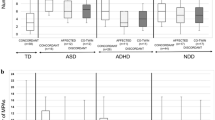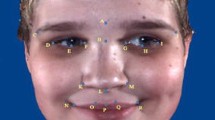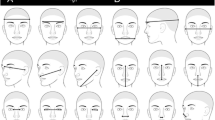Abstract
The objective of this investigation was to examine the existence of minor physical anomalies (MPA) in autism. The interorbital and interlens distances were measured on MRI scans obtained from a sample of 40 non-mentally retarded individuals with autism and 41 healthy controls. No differences were observed between the two groups on any measurements. However, when the analysis was conducted using a split median procedure, individuals with autism and either low FSIQ, PIQ, or VIQ had shorter interorbital distances when compared to controls. Hypotelorism is a MPA that may be present in a subgroup of individuals with autism. Additional research is warranted using large sample sizes with a wide range of intellectual functioning.
Similar content being viewed by others
References
Aylward, E. H., Minshew, N. J., Goldstein, G., Honeycutt, N. A., Augustine, A. M., & Yates, K. O. et al. (1999). MRI volumes of amygdala and hippocampus in non-mentally retarded autistic adolescents and adults. Neurology, 53, 2145–2150.
Aylward, E. H., Minshew, N. J., Field, K., Sparks, B. F., & Singh, N. (2002). Effects of age on brain volume and head circumference in autism. Neurology, 59, 175–183.
Bailey, A., Le Couteur, A., Gottesman, I., Bolton, P., Simonoff, E., & Yuzda, E. et al. (1995). Autism as a strongly genetic disorder: Evidence from a British twin study. Psychology Medicine, 25, 63–77.
Boyes, J., Whalley, H. C., Lawrie, S. M., Johnstone, E. C., & Best, J. J. (2001). A MRI study of ocular hypertelorism in individuals at high risk of developing schizophrenia. Schizophrenia Research, 30, 1–2.
Campbell, M., Geller, B., Small, A. M., Petti, T. A., & Ferris, S. H. (1978). Minor physical anomalies in young psychotic children. American Journal of Psychiatry, 135, 573–575.
Cohen Jr., M. M., Richieri-Costa, A., Guion-Almeida, M. L., & Saavedra, D. (1995). Hypertelorism: Interorbital growth, measurements, and pathogenetic considerations. International Journal of Oral Maxillofacial Surgery, 24, 387–395.
Diewert, V. M., Lozanoff, S., & Choy, V. (1993). Computer reconstructions of human embryonic craniofacial morphology showing changes in relations between the face and brain during primary palate formation. Journal of Craniofacial Genetics and Developmental Biology, 13, 193–201.
Hardan, A. Y., Minshew, N. J., Mallikarjuhn, M., & Keshavan, M. S. (2001). Brain volume in autism. Journal of Child Neurology, 16, 421–424.
Hollingshead, A. B. (1975). Four factor index of social status. New Haven, CT: Yale University Department of Sociology.
Jones, K. L. (1997). Smith’s recognizable pattern of human malformation (pp. 727–746). Philadelphia: W.B. Saunders.
Lainhart, J. E., Piven, J., Wzorek, M., Landa, R., Santangelo, S. L., & Coon, H. et al. (1997). Macrocephaly in children and adults with autism. Journal of the American Academy of Child and Adolescent Psychiatry, 36, 282–290.
Lord, C., Rutter, M., & LeCouteur, A. (1994). Autism diagnostic interview-revised: A revised version of a diagnostic interview for caregivers of individuals with possible pervasive developmental disorders. Journal of Autism and Developmental Disorder, 24, 659–685.
LeCouteur, A., Rutter, M., Lord, C., Rios, P., Robertson, S., & Holdgrafer, M., et al. (1989). Autism diagnostic interview: A standardized investigator-based instrument. Journal of Autism and Developmental Disorder, 19, 363–387.
Magnotta, V. A., Harris, G., Andreasen, N. C., O’Leary, D. S., Yuh, W. T., & Heckel, D. (2002). Structural MR image processing using the BRAINS2 toolbox. Computerized Medical Imaging and Graphics, 26, 251–264.
Miles, J. H., & Hillman, R. E. (2000). Value of a clinical morphology examination in autism. American Journal of Medical Genetics, 91, 245–253.
Minshew, N. J. (1996). Autism. In B. O. Berg (Ed), Principles of child neurology (pp. 1713–1730). New York: McGraw Hill.
Quinn, P. Q., & Rapoport, J. L. (1974). Minor physical anomalies and neurologic status in hyperactive boys. Pediatrics, 53, 742–747.
Rodier, P. M., Bryson S. E., & Welch, J. P. (1997). Minor malformations and physical measurements in autism: Data from Nova Scotia. Teratology, 55, 319–325.
Steg, J. P., & Rapoport, J. L. (1975). Minor physical anomalies in normal, neurotic learning disabeled, and severely disturbed children. Journal of Autism and Childhood Schizophrenia, 5, 299–307.
Walker, H. A. (1977). Incidence of minor physical anomaly in autism. Journal of Autism and Childhood Schizophrenia, 7, 165–176.
Acknowledgment
This work was supported in part by NIMH Grant MH 64027 to Dr. Hardan and NICHD Grant HD 35469 to Dr. Minshew. This study was also supported by an NICHD Collaborative Program of Excellence in Autism (CPEA).
Author information
Authors and Affiliations
Corresponding author
Rights and permissions
About this article
Cite this article
Hardan, A.Y., Keshavan, M.S., Sreedhar, S. et al. An MRI Study of Minor Physical Anomalies in Autism. J Autism Dev Disord 36, 607–611 (2006). https://doi.org/10.1007/s10803-006-0103-4
Published:
Issue Date:
DOI: https://doi.org/10.1007/s10803-006-0103-4




